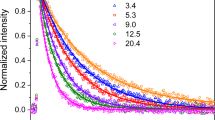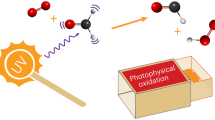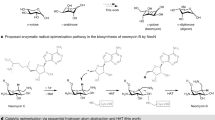Abstract
Carbohydrates (CH2O)n are the formal adducts of carbon (atoms) to water with a repeating unit that structurally resembles H–C̈–OH (hydroxymethylene). Although hydroxymethylene has been suggested as a building block for sugar formation, it is a reactive species that had escaped detection until recently. Here we demonstrate that formaldehyde reacts with its isomer hydroxymethylene to give glycolaldehyde in a nearly barrierless reaction. This carbonyl–ene-type transformation operates in the absence of base and solvent at cryogenic temperatures similar to those found in extraterrestrial environments or interstellar clouds. Hydroxymethylene acts as a building block for an iterative sugar synthesis, as we demonstrate through the formation of the triose glyceraldehyde. The thermodynamically preferred ketose dihydroxyacetone does not form, and the formation of further branched sugars in the iterative synthesis presented here is unlikely. The results therefore provide a link between the well-known formose (Butlerow) reaction and sugar formation under non-aqueous conditions.
This is a preview of subscription content, access via your institution
Access options
Access Nature and 54 other Nature Portfolio journals
Get Nature+, our best-value online-access subscription
$29.99 / 30 days
cancel any time
Subscribe to this journal
Receive 12 print issues and online access
$259.00 per year
only $21.58 per issue
Buy this article
- Purchase on Springer Link
- Instant access to full article PDF
Prices may be subject to local taxes which are calculated during checkout





Similar content being viewed by others
References
Breslow, R. On the mechanism of the formose reaction. Tetrahedron Lett. 1, 22–26 (1959).
Butlerow, A. Bildung einer zuckerartigen Substanz durch Synthese. Justus Liebigs Ann. Chem. 120, 295–298 (1861).
Schwartz, A. W. & Degraaf, R. M. The prebiotic synthesis of carbohydrates—a reassessment. J. Mol. Evol. 36, 101–106 (1993).
Socha, R. F., Weiss, A. H. & Sakharov, M. M. Auto-catalysis in the formose reaction. React. Kinet. Catal. Lett. 14, 119–128 (1980).
Huskey, W. P. & Epstein, I. R. Auto-catalysis and apparent bistability in the formose reaction. J. Am. Chem. Soc. 111, 3157–3163 (1989).
Shapiro, R. Prebiotic ribose synthesis—a critical analysis. Orig. Life Evol. Biosph. 18, 71–85 (1988).
Larralde, R., Robertson, M. P. & Miller, S. L. Rates of decomposition of ribose and other sugars—implications for chemical evolution. Proc. Natl Acad. Sci. USA 92, 8158–8160 (1995).
Toxvaerd, S. The role of carbohydrates at the origin of homochirality in biosystems. Orig. Life Evol. Biosph. 43, 391–409 (2013).
Cooper, G. et al. Carbonaceous meteorites as a source of sugar-related organic compounds for the early Earth. Nature 414, 879–883 (2001).
Kebukawa, Y., Kilcoyne, A. L. D. & Cody, G. D. Exploring the potential formation of organic solids in chondrites and comets through polymerization of interstellar formaldehyde. Astrophys. J. 771, 19 (2013).
Meinert, C. et al. Ribose and related sugars from ultraviolet irradiation of interstellar ice analogs. Science 352, 208–212 (2016).
Hollis, J. M., Lovas, F. J. & Jewell, P. R. Interstellar glycolaldehyde: the first sugar. Astrophys. J. 540, L107–L110 (2000).
Halfen, D. T., Apponi, A. J., Woolf, N., Polt, R. & Ziurys, L. M. A systematic study of glycolaldehyde in Sagittarius B2(N) at 2 and 3 mm: criteria for detecting large interstellar molecules. Astrophys. J. 639, 237–245 (2006).
Sutherland, J. D. & Whitfield, J. N. Prebiotic chemistry: a bioorganic perspective. Tetrahedron 53, 11493–11527 (1997).
Jortner, J. Conditions for the emergence of life on the early Earth: summary and reflections. Phil. Trans. Royal Soc. Lond. B 361, 1877–1891 (2006).
Snyder, L. E., Buhl, D., Zuckerma., B. & Palmer, P. Microwave detection of interstellar formaldehyde. Phys. Rev. Lett. 22, 679–681 (1969).
Kebukawa, Y. & Cody, G. D. A kinetic study of the formation of organic solids from formaldehyde: implications for the origin of extraterrestrial organic solids in primitive Solar System objects. Icarus 248, 412–423 (2015).
Shigemasa, Y., Matsuda, Y., Sakazawa, C. & Matsuura, T. Formose reactions. II. Photochemical formose reaction. Bull. Chem. Soc. Jpn 50, 222–226 (1977).
Sodeau, J. R. & Lee, E. K. C. Intermediacy of hydroxymethylene (HCOH) in low-temperature matrix photochemistry of formaldehyde. Chem. Phys. Lett. 57, 71–74 (1978).
Maity, S., Kaiser, R. I. & Jones, B. M. Infrared and reflectron time-of-flight mass spectroscopic study on the synthesis of glycolaldehyde in methanol (CH3OH) and methanol-carbon monoxide (CH3OH-CO) ices exposed to ionization radiation. Faraday Discuss. 168, 485–516 (2014).
Bennett, C. J. & Kaiser, R. I. On the formation of glycolaldehyde (HCOCH2OH) and methyl formate (HCOOCH3) in interstellar ice analogs. Astrophys. J. 661, 899–909 (2007).
Eckhardt, A. K. & Schreiner, P. R. Spectroscopic evidence for aminomethylene (H−C̈−NH2)—the simplest amino carbene. Angew. Chem. Int. Ed. 57, 5248–5252 (2018).
Schreiner, P. R. et al. Capture of hydroxymethylene and its fast disappearance through tunnelling. Nature 453, 906–909 (2008).
Feng, R., Wesdemiotis, C. & McLafferty, F. W. Gaseous negative ions from neutral molecules and positive ions: new information for neutralization–reionization mass spectrometry. J. Am. Chem. Soc. 109, 6521–6522 (1987).
Ley, D., Gerbig, D. & Schreiner, P. R. Tunnelling control of chemical reactions—the organic chemist’s perspective. Org. Biomol. Chem. 10, 3781–3790 (2012).
Schreiner, P. R. Tunneling control of chemical reactions: the third reactivity paradigm. J. Am. Chem. Soc. 139, 15276–15283 (2017).
Flanagan, G., Ahmed, S. N. & Shevlin, P. B. Formation of carbohydrates in the reaction of atomic carbon with water. J. Am. Chem. Soc. 114, 3892–3896 (1992).
Schreiner, P. R. & Reisenauer, H. P. The ‘non-reaction’ of ground-state triplet carbon atoms with water revisited. ChemPhysChem 7, 880–885 (2006).
Schreiner, P. R. et al. Methylhydroxycarbene: tunneling control of a chemical reaction. Science 332, 1300–1303 (2011).
Kemper, M. J. H., Hoeks, C. H. & Buck, H. M. A theoretical study on the reactivity and spectra of H2CO and HCOH. A dimeric model for non-zero pressure formaldehyde photochemistry. J. Chem. Phys. 74, 5744–5757 (1981).
Ahmed, S. N., McKee, M. L. & Shevlin, P. B. The unusual reactivity of hydroxymethylene. J. Am. Chem. Soc. 107, 1320–1324 (1985).
Cleaves, H. J. The prebiotic geochemistry of formaldehyde. Precamb. Res. 164, 111–118 (2008).
Pinto, J. P., Gladstone, G. R. & Yung, Y. L. Photochemical production of formaldehyde in earths primitive atmosphere. Science 210, 183–184 (1980).
Lucchese, R. R. & Schaefer, H. F. Metal–carbene complexes and possible role of hydroxy-carbene in formaldehyde laser photochemistry. J. Am. Chem. Soc. 100, 298–299 (1978).
Hibbitts, D., Dybeck, E., Lawlor, T., Neurock, M. & Iglesia, E. Preferential activation of CO near hydrocarbon chains during Fischer–Tropsch synthesis on Ru. J. Catal. 337, 91–101 (2016).
Deng, J. et al. Linked strategy for the production of fuels via formose reaction. Sci. Rep. 3, 1244 (2013).
Schäfer, M. et al. Hydrogen tunneling above room temperature evidenced by infrared ion spectroscopy. J. Am. Chem. Soc. 139, 5779–5786 (2017).
Breslow, R. On the mechanism of thiamine action. IV. Evidence from studies on model systems. J. Am. Chem. Soc. 80, 3719–3726 (1958).
Ritson, D. & Sutherland, J. D. Prebiotic synthesis of simple sugars by photoredox systems chemistry. Nat. Chem. 4, 895–899 (2012).
Ritson, D. J. & Sutherland, J. D. Synthesis of aldehydic ribonucleotide and amino acid precursors by photoredox chemistry. Angew. Chem. Int. Ed. 52, 5845–5847 (2013).
Paul, M. et al. Breslow intermediates from aromatic N-heterocyclic carbenes (benzimidazolin-2-ylidenes, thiazolin-2-ylidenes). Angew. Chem. Int. Ed. 57, 8310–8315 (2018).
Poust, S. et al. Mechanistic analysis of an engineered enzyme that catalyzes the formose reaction. ChemBioChem 16, 1950–1954 (2015).
Woods, P. M. et al. On the formation of glycolaldehyde in dense molecular cores. Astrophys. J. 750, 19 (2012).
Angyal, S. J. in Glycoscience: Epimer isa tion, Isomer isa tion and rearrangement reactions of carbohydrates Vol. 215 (ed. Stütz, A. E.) 1–14 (Springer, Berlin, 2001).
Kua, J., Galloway, M. M., Millage, K. D., Avila, J. E. & De Haan, D. O. Glycolaldehyde monomer and oligomer equilibria in aqueous solution: comparing computational chemistry and NMR data. J. Phys. Chem. A 117, 2997–3008 (2013).
Sutherland, J. D. The origin of life—out of the blue. Angew. Chem. Int. Ed. 55, 104–121 (2016).
Delidovich, I. V., Simonov, A. N., Taran, O. P. & Parmon, V. N. Catalytic formation of monosaccharides: from the formose reaction towards selective synthesis. ChemSusChem 7, 1833–1846 (2014).
Schwartz, A. W. & Degraaf, R. M. Photoreductive formation of acetaldehyde from aqueous formaldehyde. Tetrahedron Lett. 34, 2201–2202 (1993).
Clarke, M. L. & France, M. B. The carbonyl ene reaction. Tetrahedron 64, 9003–9031 (2008).
Bourissou, D., Guerret, O., Gabbaï, F. P. & Bertrand, G. Stable carbenes. Chem. Rev. 100, 39–92 (2000).
Acknowledgements
This work was supported by the Volkswagen Foundation (‘What is Life’ grant 92 748), the Fonds der Chemischen Industrie (doctoral fellowship to A.K.E.) and the Justus Liebig University (graduate fellowship to M.M.L.). The authors thank H. Hausmann for support with the NMR spectroscopic measurements.
Author information
Authors and Affiliations
Contributions
A.K.E. conducted all matrix isolation experiments and carried out all computations. A.K.E., M.M.L., and B.B. carried out all FP experiments. A.K.E. and R.C.W. conducted all data analysis. P.R.S. conceived the original working hypothesis. A.K.E. and P.R.S. wrote the manuscript.
Corresponding author
Ethics declarations
Competing interests
The authors declare no competing interests.
Additional information
Publisher’s note: Springer Nature remains neutral with regard to jurisdictional claims in published maps and institutional affiliations.
Supplementary information
Supplementary Information
Supplementary Figures 1–68, Supplementary Tables 1–6, Supplementary Methods, Supplementary Characterisation Data, Supplementary Computational Data
Rights and permissions
About this article
Cite this article
Eckhardt, A.K., Linden, M.M., Wende, R.C. et al. Gas-phase sugar formation using hydroxymethylene as the reactive formaldehyde isomer. Nature Chem 10, 1141–1147 (2018). https://doi.org/10.1038/s41557-018-0128-2
Received:
Accepted:
Published:
Issue Date:
DOI: https://doi.org/10.1038/s41557-018-0128-2
This article is cited by
-
On the Origin of Sugar Handedness: Facts, Hypotheses and Missing Links-A Review
Origins of Life and Evolution of Biospheres (2022)



